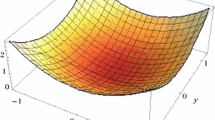Abstract
In duality theory, there is a trade-off between generality and tractability. Thus, the generality of the Tind-Wolsey framework comes at the expense of an infinite-dimensional dual solution space, even if the primal solution space is finite dimensional. Therefore, the challenge is to impose additional structure on the dual solution space and to identify conditions on the primal program, such that the properties that are typically associated with duality, like weak and strong duality, are preserved.
In this paper, we consider real-valuedness, continuity, and additive separability as such additional structures. The virtue of the latter property is that it restores the one-to-one correspondence between primal constraints and dual variables as it exists in Lagrangian duality. The main result of this paper is that, roughly speaking, the existence of realvalued, continuous, and additively separable dual solutions that preserve strong duality is guaranteed, once the primal program satisfies a certain stability condition. The latter condition is ensured by the well-known regularity conditions that imply constraint qualification in Karush-Kuhn-Tucker points. On the other hand, if instead of additive separability, a mild tractability condition is imposed on the dual solution space, then stability turns out to be a necessary condition for strong duality in a well-defined sense. This result, combined with the observation that applicability of some well-known augmented Lagrangian methods to constrained optimization.
Similar content being viewed by others
References
Everett, H.,Generalized Lagrange Multiplier Method for Solving Problems of Optimum Allocation of Resources, Operations Research, Vol. 11, pp. 399–417, 1963.
Gould, F. J.,Extensions of Lagrange Multipliers in Nonlinear Programming, SIAM Journal on Applied Mathematics, Vol. 17, pp. 1280–1297, 1969.
Burdet, C. A., andJohnson, E. L.,A Subadditive Approach to Solve Linear Integer Programs, Annals of Discrete Mathematics, Vol. 1, pp. 117–144, 1977.
Jeroslow, R. G.,Cutting Plane Theory: Algebraic Methods, Discrete Mathematics, Vol. 23, pp. 121–150, 1978.
Elster, K. H., andNehse, R.,Zur Theorie der Polarfunktionale, Mathematische Operationsforschung und Statistik, Vol. 5, pp. 3–21, 1974.
Rockafellar, R. T.,Augmented Lagrange Multiplier Functions and Duality in Nonconvex Programming, SIAM Journal on Control, Vol. 12, pp. 268–285, 1974.
Balder, E. J.,An Extension of Duality-Stability Relations to Nonconvex Optimization Problems, SIAM Journal on Control and Optimization, Vol. 15, pp. 329–343, 1977.
Dolecki, S., andKurcyusz, S.,On ф-Convexity in Extremal Problems, SIAM Journal on Control and Optimization, Vol. 16, pp. 277–300, 1978.
Evers, J. J. M., andVan Maaren, H.,Duality Principles in Mathematics and Their Relations to Conjugate Functions, Nieuw Archief voor Wiskunde, Vol. 4, pp. 23–68, 1985.
Tind, J.,On Duality in Nonconvex and Integer Programming, Operations Research Verfahren, Vol. 32, pp. 193–201, 1979.
Tind, J., andWolsey, L. A.,An Elementary Survey of General Duality Theory in Mathematical Programming, Mathematical Programming, Vol. 21, pp. 241–261, 1981.
Burkard, R. E., Hamacher, H., andTind, J.,On Abstract Duality in Mathematical Programming, Zeitschrift für Operations Research, Vol. 26, pp. 197–209, 1982.
Fiacco, A. V.,Introduction to Sensitivity and Stability Analysis in Nonlinear Programming, Academic Press, New York, New York 1983.
Flippo, O. E., andMinoux, M.,Continuity of the Value Function in Mathematical Programming: A Unifying Framework with New Results, Report, No. 8903/A, Econometric Institute, Erasmus University Rotterdam, 1989; LAMSADE Document No. 52, Université de Paris—Dauphine, 1989.
Flippo, O. E.,Stability, Duality, and Decomposition in General Mathematical Programming, Stichting Mathematisch Centrum, Amsterdam, Netherlands, 1990.
Bertsekas, D. P.,Constrained Optimization and Lagrange Multiplier Methods, Academic Press, New York, New York, 1982.
Ponstein, J.,Comments on the General Duality Survey by J. Tind and L. A. Wolsey, Mathematical Programming, Vol. 25, pp. 240–244, 1983.
Hogan, W. W.,Point-to-Set Maps in Mathematical Programming, SIAM Review, Vol. 15, pp. 591–603, 1973.
Author information
Authors and Affiliations
Additional information
Communicated by F. Giannessi
This study was supported by the Netherlands Foundation for Mathematics (SMC) with financial aid from the Netherlands Organization for Scientific Research (NWO).
Rights and permissions
About this article
Cite this article
Flippo, O.E., Rinnooy Kan, A.H.G. Additively separable duality theory. J Optim Theory Appl 88, 381–397 (1996). https://doi.org/10.1007/BF02192177
Issue Date:
DOI: https://doi.org/10.1007/BF02192177



